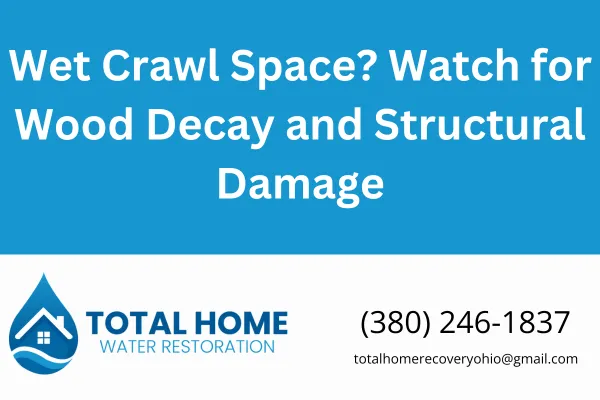
Wet Crawl Space? Watch for Wood Decay and Structural Damage
Wet Crawl Space? Watch for Wood Decay and Structural Damage
If you’ve found standing water or high humidity in your crawl space, you’re right to be concerned. Wet crawl spaces don’t just smell bad—they rot wood, attract mold, and threaten the structure of your home. At Total Home Water Restoration, we’ve seen the damage firsthand in Grove City and throughout Central Ohio.
Here’s what you need to know about crawl space water damage and how to stop wood decay before it wrecks your floor framing.
What Happens When Your Crawl Space Gets Wet
When water sits under your home, it doesn’t just evaporate and disappear. It soaks into the wood joists, beams, and subfloor above. Over time, that leads to:
Fungal growth (wood rot) – This eats away at the wood fibers, weakening beams and joists.
Termite and pest issues – Damp wood is an open invitation for pests.
Mold growth – Mold spreads fast in dark, humid crawl spaces.
Warping and sagging floors – If the subfloor or joists are compromised, your floors above may slope or bounce.
Why Wood Decay Is a Serious Problem
Wood rot isn’t just surface-level damage. Once decay fungi set in, they digest the wood’s structural components. This can leave joists brittle, cracked, or even collapsing. In severe cases, we’ve had to fully replace crawl space framing and subfloors due to neglect.
It’s not just about safety either. If you’re planning to sell your home, inspectors will flag structural decay—and it’s expensive to fix last-minute.
Signs You Might Have Wood Decay
Don’t wait until you see mushrooms growing. Watch for:
Musty odors inside the home
Sagging or uneven floors
Cracks where walls meet the floor
High humidity or visible moisture in the crawl space
Crumbling or soft spots in floor framing
If you see these, it’s time to act.
How We Fix It at Total Home Water Restoration
We approach wet crawl spaces and wood decay with a clear plan:
Inspect the crawl space thoroughly – We check for active leaks, rot, and framing condition.
Dry it out – We use professional-grade dehumidifiers and drainage solutions.
Remove and replace decayed wood – Following IRC code R408.3 and IICRC S520 standards, we replace compromised joists and beams.
Install moisture control systems – This might include vapor barriers, French drains, or sump pumps.
Treat for mold or pests if needed – Mold doesn’t stop just because you dried things out.
What You Can Do Now
Don’t ignore a musty smell in your home.
Take a peek in your crawl space (or call us to do it).
Keep gutters and downspouts clean and directed away from your foundation.
Make sure your crawl space has proper ventilation and no standing water.
FAQ
Q: Is wood rot from a wet crawl space covered by homeowners insurance?
A: It depends. If the moisture came from a sudden pipe break, insurance may help. But gradual moisture or poor drainage usually isn’t covered. We can help you assess and document.
Q: Can you save wood that’s starting to decay?
A: Sometimes. If caught early and the damage is minor, reinforcing or treating the wood can work. But structural safety always comes first.
Need Help with a Wet Crawl Space in Grove City or Columbus?
Call Tyler Zimmerman at Total Home Water Restoration: 380-246-1837. We’ll inspect, repair, and make sure your home is protected from the ground up.
